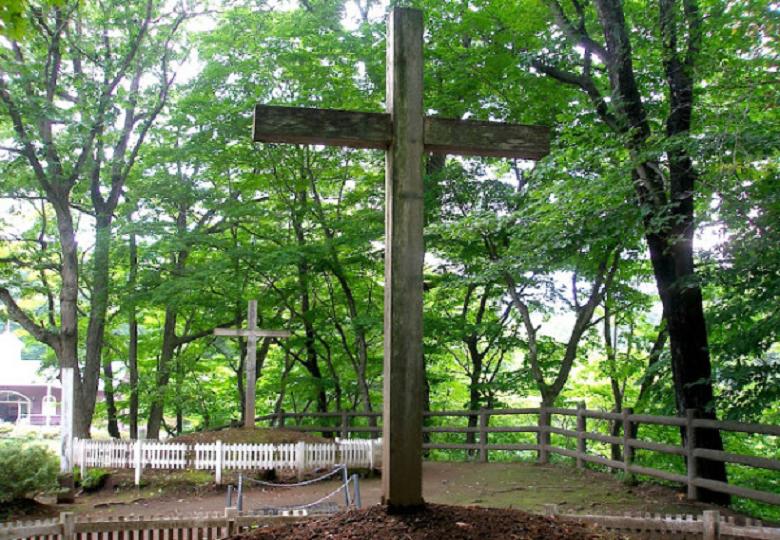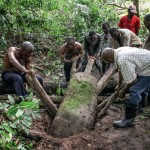
A tomb of a traveling shepherd lies on a flat peak of a steep hill in the far away region of North Japan. It is believed that around 2000 years ago, he settled there to cultivate garlic.
The shepherd fell in love with Miyuko, the daughter of a local farmer. They had three kids, and the shepherd passed away at the ripe old age of 106. In the mountain region of Shingo, the shepherd was remembered as Daitenku Taro Jurai, while the rest of the word knew him as Jesus Christ.
It appears that Christ of Nazareth, the Messiah in the Christian religion didn’t actually die on the cross as has been thought until now. According to local Japanese folklore, the one who was crucified was actually his brother, Isukiri whose severed ear is buried in a neighboring hill in Japan.
In the forsaken shepherd village, there was only one Christian and in a radius of 30 miles there isn’t even a church but that doesn’t change the fact that Shingo was known as Kirisuto no Sato (City of Christ). The place is visited by more the 20 000 pilgrims every year. There is also a museum in the vicinity known as the Legend of Christ.
In the region of Shingo the story goes like this: Christ first visited Japan when he was 21 years old so he could study theology. This happened in the so called period of the “lost years” – 12 years in which there is no information about the location of Christ in the New Testament. Christ had become a disciple of a well-known master near the mountain of Fuji, learning the Japanese language and the Eastern culture as a whole. At the age of 33, he returned to the city of Judea.
Christ became a problem for the Roman authorities, and he was arrested and sentenced to crucifixion because he was accused of heresy. But he fooled authorities by switching places with the less-known Isukiri. To escape further persecution, Christ went back to Japan, bringing with him only two “souvenirs” – one of his brother’s ears and a lock from Virgin Mary’s hair.
After reaching the village of Shingo, Christ devoted himself to a life in exile, accepted a new identity and built a family. In the village, it is said that he lived his life helping those in need. His hair had turned gray and he wore a multilayered robe, but what the locals noticed most was his nose – in a brochure in the nearby museum, it was said that he had the reputation of a “long-nosed goblin”.
When Christ passed away, his body was laid out at the top of the hill for 4 years. After that, going along with tradition, his bones were collected and buried in a hill – at the moment there is a giant cross atop of it.
People from the museum argue that local dialect consists of the words aba and gaga (mother) and aya and dada (father), which are closer to the Hebrew language, rather than the Japanese one. The older name of the village – Heraimura – can be traced back to the early Middle Eastern diaspora.
It’s as if this unbelievable theory comes into light back in 2004, when the Israeli ambassador, Eli Cohen visited the tombs in Shingo and dedicated a tablet written in Hebrew in honor of the connection between Shingo and Jerusalem. The explanation of the tablet was that it appeared as a symbol of friendship, rather than a confirmation of the legend.
The key to unveiling the truth was most likely an ancient scroll, which is believed to be the last testament, dictated by Christ himself just a before his death. According to the museum, the scroll was found in 1936 by “archeologists, associated with an international society with the purpose of exploring ancient literature”. The scroll is destroyed during World War II…
Despite many doubts regarding the legitimacy of the legend, in its defense, it should be mentioned that people from the Sawaguchi tribe (the long-standing owners of the land where Jesus was thought to have lived) had blue eyes – a trait that is, to say the least, very unorthodox for the Japanese people. According to historian, Banzan Toya, this is proof that those people are descendants of Jesus and Miyoko (also known as Yumiko, Miyo and Mariko).
Junichiro Sawaguchi – the oldest member of the family, which is believed to have stemmed from Jesus himself – honors holidays like every common Japanese person. He is a clerk in the city hall and has never read the Bible or gone to Church.
“I am a Buddhist,” explains Sawaguchi. When asked if he believes he is a descendent of Jesus Christ, he answers that he doesn’t know.
According to Chris Carlsen, who teaches English in that region, Japanese people are very tactful when it comes to discussing self-contradictory subjects. “The tomb of Christ has given Shingo the feeling of uniqueness. If an important figure such as Mr. Sawaguchi rejects the legends, he would look like a traitor to the community,” Carlsen explains.


